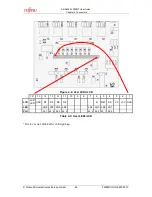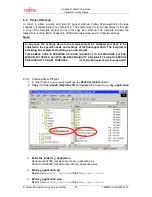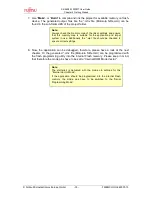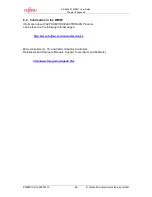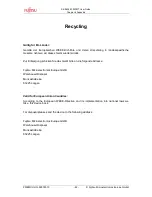
SK-96380-120PMT User Guide
Chapter 7 Programming the internal Flash memory
© Fujitsu Microelectronics Europe GmbH
- 35 -
FMEMCU-UG-960001-15
2) If the programming software should generate a reset signal on RTS or DTR line, refer
to the following jumper list.
Jumper
Programming
UART
Setting Description
Closed RTS and CTS of X5 are connected
JP19
(RTS-CTS)
UART0
Open
RTS and CTS of X5 are not connected
UART0 1-2
DTR signal (Pin 6 of X5) is used as reset
source
JP23
(DTR/RTS)
UART0 2-3
RTS signal (Pin 7 of X5) is used as reset
source
Closed RTS and CTS of X9 are connected
JP36
(RTS-CTS)
UART2
Open
RTS and CTS of X9 are not connected
UART2 1-2
DTR signal (Pin 6 of X9) is used as reset
source
JP38
(DTR/RTS)
UART2 2-3
RTS signal (Pin 7 of X9) is used as reset
source
UART0
1-2
LIN-UART 0 (X5) connected to reset circuit
JP33
(RESET A/B)
UART2
2-3
LIN-UART 2 (X9) connected to reset circuit
1-2
No negation for the DTR/RTS signal
JP41
(DTR /
DTRx)
-
2-3
DTR/RTS signal is negated
1-2
Reset is applied immediately when SW6 is
pressed
JP46
(Direct RST)
-
2-3
Reset is applied when SW6 is pressed >2sec
Table 7-2: Jumper Settings for reset signal
3) The CPU Mode selection must be set to internal reset vector mode by setting DIP
switch S1 to Off, On, Off, X.
4) Start the ‘Flash Memory Programmer 16FX’ and connect the UART0 or 1 to your
serial PC communication port. A straight cable connection has to be used.
5) Choose the microcontroller device (MB96F387) as target microcontroller and 4 MHz
for crystal frequency. Then browse to the
mhx
-file you want to program to the
embedded flash memory of the microcontroller. Press the button “Full Operation” to
start programming.
Note, that the COM port of the PC can be set in the Option ‘Set Environment’.





